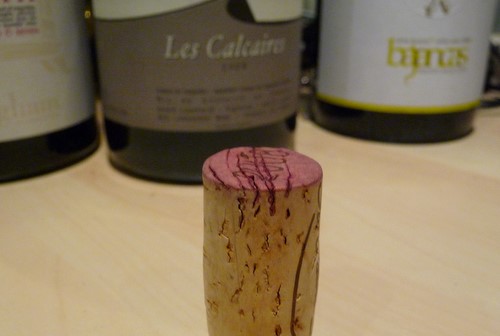I don’t get all that many cork-tainted wines these days. Part of this is that I’m opening quite a few bottles sealed with alternative closures, but also the proportion of tainted natural corks seems to have dropped a little. But I had a big disappointment with a bottle I opened yesterday – one that I was really looking forward to trying. It was a Pic St Loup from Cazeneuve, and it was really nastily corked.
There’s a picture of the offending cork above. Again, a common feature with badly corked wines seems to be big lenticels (the pores in the cork bark that allow gas exchange) running through the wine-contacting face of the cork. Could it be that these harbour the microbes making the haloanisoles that taint the wine?
The other disappointment was the latest vintage, 2007, of the Bellingham Bernard Series Basket Pressed Syrah from South Africa. At £10 in Sainsbury’s, the 2006 was a real hit. The 2007 has lovely fruit, but far, far too much new oak. Such a shame. Over-oaking is almost as bad as cork taint.
3 Comments on A couple of disappointments, one corky



Jamie – I’m wondering about “over-oaking” constantly being slagged off in the wine Press over the last several years. And whilst I like a decent bit of oak myself, if used with an appropriately powerful wine, I agree that over-oaking or out of balance oaking is annoying. I also don’t get it, as new barrels and barrel work is expensive. Though of course, many over-oaked wines could have been treated with chips or staves. But you could still argue that it is money down the drain.
I was lucky enough to share a couple of days with a famous consultant a couple of weeks ago. He thought that whilst the Press talks down oak, people actually love it.
Would be an interesting blind tasting across 3 groups of people:
no oak / lightly oaked / heavily oaked / massively over oaked wines
for (a) general public / (b) wine enthusiasts / (c) wine trade
What styles would “win” I wonder?
It does surprise me in this day and age that winemakers (or is it marketing guru’s?) still use dodgy natural punched cork – there are so many alternatives. When will these people wake up? The consumer deserves consistency, time after time, not running constant risk of taint. Opened a pretty pricey Pinotage the other night.. corked. Disappeared down the sink. What a waste, and unfortunately I’ll not be spending my hard earned on that particular wineries wines again.
Jamie,
I’ve had the same experience with TCA-tainted wines often having corks with large lenticels (or cracks, to use the layman’s term for the phenomenon) running across their contact face. Over the years, I’ve also noticed another phenomenon: some corked wines leave a grayish/muddy looking stain on the contact face, different from the typical color imprint. It’s not the clearest picture, but you’ll find an example of what I mean at:
http://mcduffwine.blogspot.com/2010/02/color-corked.html
It’s not the most common phenomenon, but I find that when the type of “off” pigmentation I’m describing appears, the wine is almost invariably corky. I can’t help but wonder if you’ve encountered anything similar and, more so, if you might have any explanation of the cause.